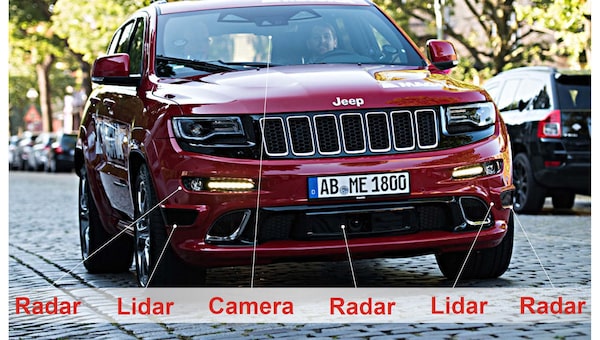
Magna's MAX4 Autonomous Driving Platform includes radar, Lidar and ultrasonic sensors coupled with a customizable computing system.Magna
You would think that when it comes to making autonomous cars, getting them to drive themselves would the hard part. That’s only about half-right.
Self-driving vehicles do indeed require a host of advanced sensors and computing power to work, but the bigger challenge facing the auto industry now might be hiding all of that technology from sight and keeping it clean and in working order.
The cars can’t drive themselves if they can’t effectively see, after all, yet no one wants a big radar dish on the roof.
Magna International, for one, believes the problem has multiple solutions. On the one hand, the Aurora, Ont.-based car-parts maker is taking a practical approach by developing specialized coatings, heating modules and retractable high-pressure sprayers that can keep radar sensors and cameras free from dirt, rain and ice.
The other approach, which may well be the better one, is to ensure that cars have multiple sensors that can perform the same jobs.
“Redundancy is very important,” says Tom Toma, global product manager for Magna Electronics. “You’re not always going to be able to jump out of your vehicle to clean your camera sensor, but maybe you have two out of three sensors fully functional and able to perform the automated driving task.”
The two-pronged approach is evident in MAX4, the autonomous-driving platform that Magna introduced last summer. The platform, which the company is offering to auto makers as an all-in-one autonomous-driving package, includes radar, Lidar and ultrasonic sensors coupled with a customizable computing system.
Magna says the platform is capable of up to Level 4 autonomy, or highly advanced self-driving that doesn’t require human input.
The platform also highlights how far sensor and computing technologies have come in terms of integration with cars. Ten years ago, autonomous vehicles more closely resembled moving laboratories, with bulky radars and cameras stacked on exteriors and computers and monitors jammed into interiors.
The technology has shrunk down and mostly melted into the background, to the point where today’s Level 4-capable cars – which aren’t yet street-legal but are being tested in many countries – are virtually indistinguishable from regular vehicles.
Moore’s Law – the long-held technology principle that specifically applies to the doubling of transistors on an integrated circuit, but which more broadly refers to the rapid improvement and shrinking of hardware explains some of it.
Auto makers and parts suppliers have also developed new materials and methods that help make those sensors virtually invisible. Magna, for example, has patented a radar cover that uses several different layered materials. The results are sensors that can perform their tasks, but which appear as just a small disc on a car’s bumper.
“We have a very homogeneous transmission of the signal,” says Brian Krull, global director of innovation for Magna Exteriors. “It can also be styled a number of different ways … even chrome appearances that we can transmit radar through.”
Not all sensors can be made completely invisible, though. Cameras, for example, need to have unobstructed views if they are to work properly. Magna believes that both consumers and its direct auto-maker customers are increasingly accepting that fact.
“There’s a level of acceptance where they say, ‘Okay, I’m willing to have a visible camera sensor so that I can cover these scenarios,’ ” Toma says. “In the past, it was styling that really drove the vehicle, but now you’re seeing more and more that technology is driving sales.”
One of the biggest challenges facing suppliers now lies in making Lidar – a form of radar that uses laser pulses to detect distances – smaller and more affordable. The technology is considered key to advanced autonomy, but the sensors can still be bulky and costly.
A number of technology companies are working on so-called solid-state Lidar.
Silicon Valley-based Velodyne announced earlier this year that it had managed to slash the price of its VLP-16 solid-state Lidar in half, to US$4,000. Magna also recently announced a deal to supply BMW with solid-state Lidar through a partnership with Israeli company Innoviz Technologies, which reportedly sells its current units for less than $1,000.
Quebec City-based LeddarTech – which counts Britain-based Magna competitor Delphi Technologies as an investor – is being even more aggressive, with a plan to offer a similar device for $100 by 2020.
The company believes its reference guide designs and specialized systems-on-a-chip will help bring size and costs down rapidly.
“Solid state is more reliable than mechanical because it doesn’t have all these moving parts,” LeddarTech spokesman Anthony Baldini says. “You add it all together and you have a sub-$100 price point that still meets all the production and performance requirements.”
Industry experts are optimistic about solid-state Lidar’s usefulness, but they question how fast this sort of low-cost mass production will arrive.
“There is sometimes a shortage of the hardware and it’s just being used for research-related purposes, so bringing it to mass production might be difficult,” says Nikolas Stewart, autonomous vehicles program manager at the University of Waterloo. “It all comes down to scale and how many you can sell.”
Shopping for a new car? Check out the new Globe Drive Build and Price Tool to see the latest discounts, rebates and rates on new cars, trucks and SUVs. Click here to get your price.
Sign up for the weekly Drive newsletter, delivered to your inbox for free. Follow us on Instagram, @globedrive.
Petrina Gentile gets behind the wheel of BMW's top-of-the-line sedan that boasts level two autonomous driving features.